Sensing Air Pollution
Air-Quality
Our Air-quality case study is based on three main components:
- a SensorBox;
- a smartphone with the free app AirProbe;
- a dedicated Web server and Web applications;
The SensorBox is a portable device that measures concentrations of pollutants in the air and localize them through a GPS. This is done one time per second in order to have a detailed map of the pollution while you walk around. Using a smartphone with AirProbe it is possible to see the measurement in real time using a bluetooth connection with the SensorBox. Morever using an Internet connection, AirProbe sends all the measurements to the EveryAware server that collects in real time data from all users. Through dedicatd Web Applications users can access the ensemble of the data gathered by the community of users along as personalized information concerning personal levels of exposure to pollutants.
SensorBox
Our SensorBox is a small measuring system which use different low-cost gas sensors to evaluate air pollution. It is small enough to be carried around in a backpack and is powered with an external battery.
SensorBox has a small fan that pushes external air into a chamber where there are different sensors that measure air pollutants. In order to realize a small and cheap device we used a series of low-cost gas sensors.  These perform well in highly controlled environments like a lab while in real-life conditions their performance and accuracy are affected by a series of factors like wind, weather condition or interfering gases. So it is very difficult to give a precise and reliable reading of a pollutant’s concentration with individual sensors. The main challenge of our SensorBox is whether the coupling of several different low-cost sensors helps in reducing disturbances and provide with a sufficiently accurate measurements. Our SensorBox is calibrated against certified instruments detecting Ultra Fine Particle (UFP) and Black Carbon, the goal being that of providing reliable observables to quantify air pollution even without individually accurate gas sensors. In particular we are using the following sensors:
These perform well in highly controlled environments like a lab while in real-life conditions their performance and accuracy are affected by a series of factors like wind, weather condition or interfering gases. So it is very difficult to give a precise and reliable reading of a pollutant’s concentration with individual sensors. The main challenge of our SensorBox is whether the coupling of several different low-cost sensors helps in reducing disturbances and provide with a sufficiently accurate measurements. Our SensorBox is calibrated against certified instruments detecting Ultra Fine Particle (UFP) and Black Carbon, the goal being that of providing reliable observables to quantify air pollution even without individually accurate gas sensors. In particular we are using the following sensors:
Alphasense CO-BF, CO sensor: Of all tested low cost gas sensors, this sensor obtained the best results for detecting the presence of traffic pollution. With it’s price tag of around 180 euro (sensor electronics included) it is also by far the most expensive selected gas sensor. Although the electrochemical cell does not use any electricity itself, the used sensor electronics do require up to 200 mW.
E2V MiCS-5521, CO sensor, and MiCS-2710, NO2 sensor: The sensors are not well suited to be used as stand-alone air quality sensors due to quite large problems with cross sensitivities. We believe they have potential when being combined with other sensors in a sensor array. The sensors have proven to be able to react on low CO and NO2 concentrations present in ambient air. With a price tag of less then 5 euro a piece, they are very attractively priced. Thanks to their micro-hotplate technology, their power usage stays quite low (less then 100 mW).
E2V MiCS-5525, CO sensor with charcoal filter: This sensor contains exactly the same sensitive element as the MiCS-5521 CO sensor. This sensor only differs by the presence of a charcoal filter which has been added on top of the sensitive element. Although we noticed this charcoal filter to increase the sensor reaction time and reduce the sensor sensitivity, it also enhances the selectivity of the sensor. With a price tag of less then 5 euro, we believe it may be able to offer us a cost effective way to help distinguish the target gas from interfering gases.
Figaro 2201, gasoline and diesel sensor: This is a metal oxide sensor which contains two sensing elements. One which is specially designed to react on the presence of gasoline exhaust fumes (mainly on CO, H2 and HC) and a second to react on the presence of diesel exhaust fumes (mainly on NOx). Figaro designed this dual sensor for the automotive industry to be used in intelligent vehicle ventilation systems. Although this sensor was not included in the lab experiments, we observed this sensor to react on the presence of traffic pollutants in ambient air. Just as the E2V sensor, also this metal oxide sensor seems be quite sensitive to cross sensitivities, making it a requirement to combine this sensor with other sensor to realize reliable air quality measurements. With a price tag of around 15 euro and a power usage of around 500 mW, the Figaro has slightly less attractive specifications.
E2V MiCS-2610, Ozone sensor: The selected E2V sensors have proven to be very sensitive towards the presence of ozone during the field experiments. For this reason, we expect an Ozone sensor may be able to add additional useful information to the sensor array. Also this E2V sensor has a low power usage and price tag.
Applied Sensors AS-MLV, VOC sensor: With this sensor, Applied Sensors is on the first place aiming on automated ventilation systems which need to be able to detect a bad indoor air quality. The concentrations of VOC in an indoor environment can be significantly higher as in an outdoor environment. Since traffic pollution also contains VOC, this sensor may be able to add information to our sensor array.
Sensirion SHT21, T and RH sensor: Low cost gas sensors are very sensitive to changes in both temperature and relative humidity. By adding high quality temperature and humidity sensor to the sensor array we expect to be able to enhance the obtained measurement results. The combined sensor of Sensirion was selected due to its high measurement precision and our good experiences in the past with these sensors.
Data gathered from sensors are read by a microcontroller board and stored on SD card. These measurements are saved together with the position given by a GPS module. A Bluetooth module allows the connection with a smartphone to transfer all the data collected for real-time visualization through the smartphone and/or forward to the main server.
AirProbe mobile application
Application purposes
AirProbe allows the user to monitor Air Pollution and enrich the readings with personal annotations. It represents the interface between the SensorBox and the main server and it is primarily designed to:
– display information about the current air quality;
– record the user trip: Air Probe receives georeferenced data collected in real time from sensor box and shows them on a map;
– let the user to annotate his journey: every user action is done in a simple and quick way. Actions as opening the Bluetooth connection, recording a trip and seeing it on a map, inserting a personal annotation are easily perfomed in a few steps.
A track is the journey that one person takes and is created when the user turns on the SensorBox and ends when the SensorBox is switched off. In this timelag, the connection between the sensor box and the smartphone is active.
Application general structure & display modes
AirProbe is composed by different views, associated to different functionalities, and organized in “tabs”:
– Map : There are two modes: user track map mode and community map mode; in user track map mode, the app shows the track corresponding to the georeferenced measures received in real time from the SensorBox; in community map mode, the app shows only the subjective annotations made by the community of users around the current position;
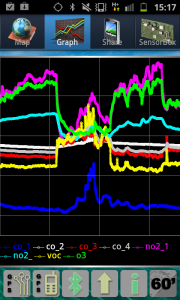 – Graph: a real time graphs shows the current values, received from the SensorBox of the 8 pollutant sensors;
– Graph: a real time graphs shows the current values, received from the SensorBox of the 8 pollutant sensors;
– Share: it lets the user to log in on Facebook and Twitter (to share georeferenced annotations and pollutants data);
– Sensor box: it shows helpful information on the status of Bluetooth connection, technical data about sensors as well as the Gps status.
The app needs an Internet connection to send data to the server and to display them on Google Maps. To avoid loss of data, it uses a store’n’forward mechanism that allows to store locally data when internet connection is not available and send them to the server when the connection becomes active again.
Air probe adapts to different “user profiles”
The functionalities and interaction modes of Air Probe are studied to let different types of users to use the application in a simple way. For example, if you are a cyclist, the minimalist and simple interface quickly let you to check the current air quality, to insert annotations (limited text entry), record trips and send the info to the server for offline analysis via a web application. If you are a mum, and every day you repeat the same journey to walk your children to or from school, you must only switch on Air Probe and forget it in your bag. Get it from your bag only if you decide to annotate what you noticed during the journey, or to check the level of exposure at every time!
 In the same whay, if you are a commuter, you can record your everyday track to collect a denser set of reading in an aggregated area and, if you go to work using public transport, you have time to annotated you experience.
In the same whay, if you are a commuter, you can record your everyday track to collect a denser set of reading in an aggregated area and, if you go to work using public transport, you have time to annotated you experience.
Different types of user can benefit from using this application: runners, pedestrians, tourists, and so on…
Measurement examples
The picture above shows an example of measurement performed in Turin. The yellow trace represents the output of a CO sensor. The highest value of gas concentration were measured along the main road, highlighted in red, expecially at the intersections. The green area, instead, is a pedestrian area where the gas level is clearly lower. Below you can see other examples of traces for different gases.
5 Responses to Air-quality
Leave a Reply Cancel reply
Events
- 16 Feb 12 - London - The Second London Citizen Cyberscience Summit
- 9 Jun 12 - Roma - SeGiochiFaiScienza
- 29 Oct 12 - Bologna - Smart City Exhibition
- 20 Mar 13 - Kassel - EveryAware Meeting - Kassel, 20-22th March 2013
Recent Comments
- Tania Hayes on Documentation for Air Ambassadors
- p.gravino on Air-quality
- latha bhaskaran on Air-quality
- alfred on Air-quality
- Jessica_P on EveryAware at CeBIT 2014
Tag Cloud
AirProbe International Challenge APIC Antwerp APIC Kassel APIC London APIC Turin awareness brussels CeBIT citizen science crowdsourcing crowdsourcing data validation environment EU events everyaware extreme citizen science fair Fukushima games geographical information geospatial information Germany Google Hannover health indignad@s internet internet and societies Marian Steinbach mobility muki haklay naples nuclear energy occupywallst openstreetmap opinion dynamics opinions paradiso participatory sensing press release publication publications radioactivity societies state of the map sustainability swiftriver UCL Uncategorized ushahidi waste webCategories

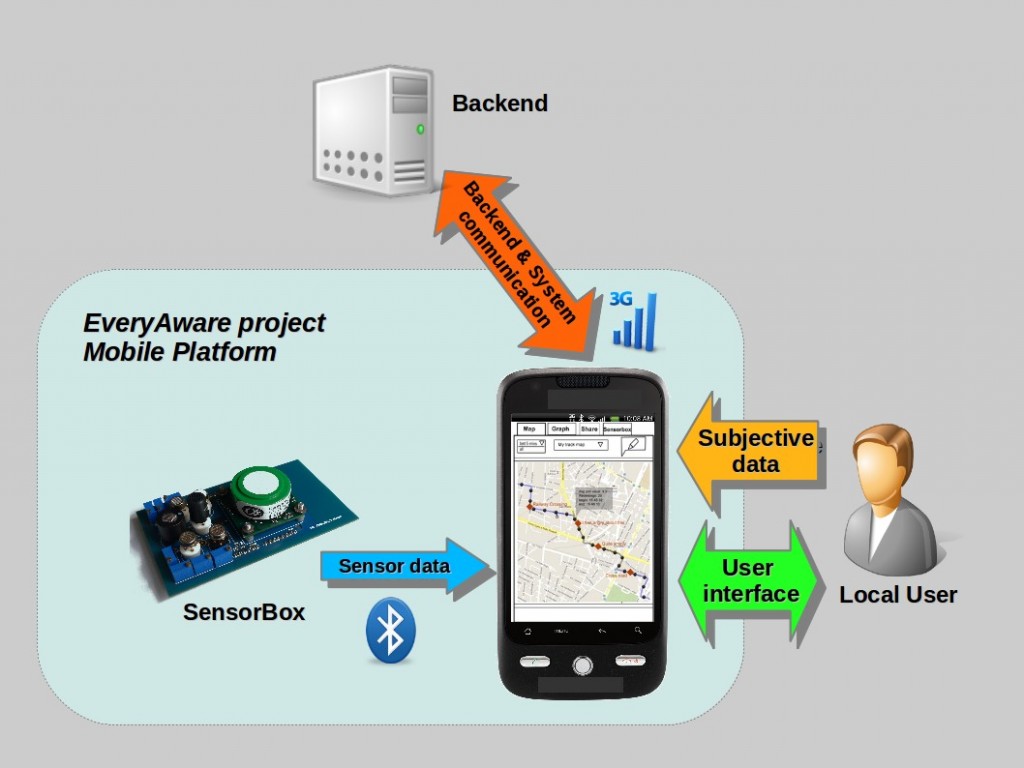


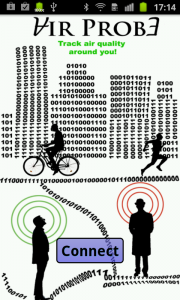
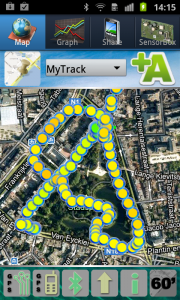



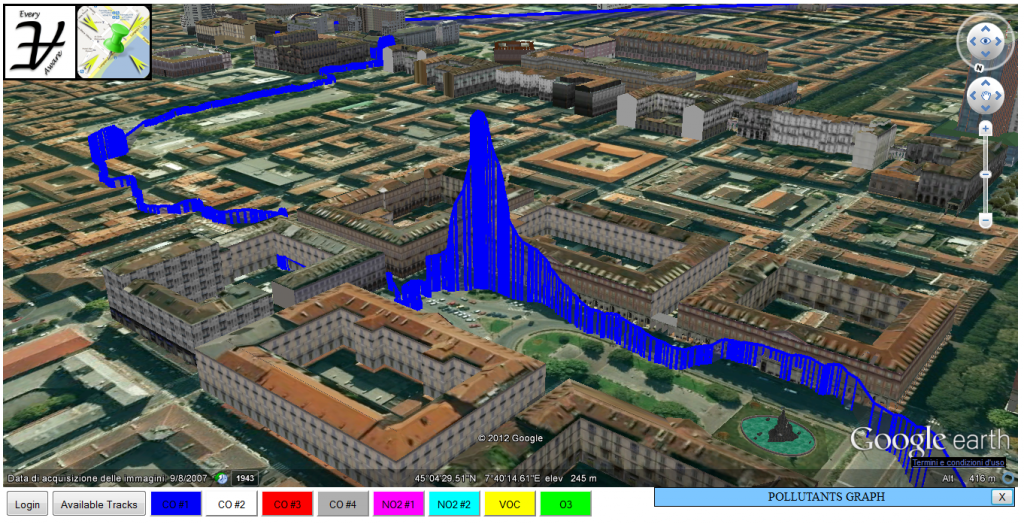








Hello I am interested about your sensor box, where I can buy it or get information to build itself.
Regards Juha Pasanen Finland
Hi,
I would like to measure NO2 and DEEE (Diesel Emissions – effectively elemental carbon is used as a surrogate) and CO2 continuously real-time over a 30 day period.
Can you help?
I would like to measure NO2, SO2, CO and
hydrocarbons to heat the boilers of a concrete production plant. The sensor box can help me? Where can buy it
Regards
Alfred
Environmental engineer
Albania
Sir,
Im in need of the sensor box. Can you please tell me from where can i get it? Or to whom i have to contact?
Kindly help me immediately.
Yours truly,
Latha
Hi everybody,
currently the EveryAware sensor-box is not available for purchase. We are now exploring opportunities for commercial development. More on this topics will follow on our blog. Stay tuned!